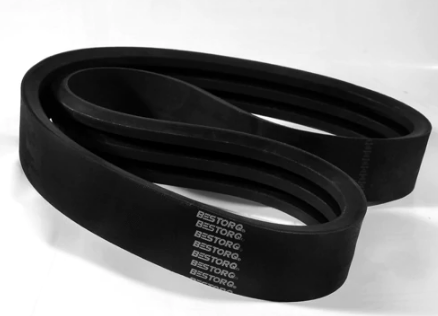
High-Performance Gear Systems | Custom Solutions for Heavy-Duty Applications
Browse our precision-engineered gearboxes, hydraulic spindles, and cast housings – designed for extreme durability, 30% longer lifespan, and seamless OEM integration.A ribbed belt, also known as a multi-rib belt or poly-V belt, is a power transmission belt characterized by several longitudinal ribs running along its inner surface. These ribs engage with corresponding grooves in pulleys, providing efficient power transfer with minimal slippage. Ribbed belts are widely used in automotive engines, industrial machinery, and appliances due to their high flexibility, durability, and ability to transmit power over multiple pulleys in compact spaces. They offer advantages over traditional V-belts, including higher power capacity, reduced vibration, and longer service life, making them a preferred choice for modern mechanical systems.
Our ribbed belts are manufactured to meet international standards such as ISO 9010 and SAE J1459, ensuring reliability and performance. Below is a detailed table of common specifications for our product range.
| Parameter | Description | Typical Values |
|---|---|---|
| Belt Type | Number of ribs and cross-section designation (e.g., PK profile) | 3PK, 4PK, 5PK, 6PK, 7PK, 8PK, 9PK, 10PK |
| Length (Pitch Length) | Effective length measured along the pitch line, in millimeters or inches | 500 mm to 2500 mm (custom lengths available) |
| Width | Overall width of the belt including ribs | 9.5 mm to 25 mm, depending on rib count |
| Rib Pitch | Distance between the centers of adjacent ribs | 2.34 mm or 3.56 mm for standard profiles |
| Tensile Strength | Maximum force the belt can withstand before breaking | Up to 2000 N per rib, varies with material |
| Operating Temperature | Range within which the belt performs optimally | -40°C to 120°C |
| Material Composition | Primary materials used in construction | Neoprene or EPDM rubber with polyester cord reinforcement |
| Standards Compliance | International quality and safety standards | ISO 9010, SAE J1459, DIN 7753 |
| Application Examples | Common uses in various industries | Automotive serpentine belts, HVAC systems, industrial conveyors |
Q: How do I identify the correct ribbed belt for my application?
A: To identify the right ribbed belt, check the number of ribs (e.g., 6PK), the pitch length (usually printed on the old belt or in the vehicle manual), and the cross-section profile (e.g., PK, PJ). Refer to manufacturer specifications or use a belt sizing tool based on pulley diameters and center distance. Always match the belt to the OEM requirements for optimal performance.
Q: What causes ribbed belt failure, and how can it be prevented?
A: Common causes of failure include misalignment of pulleys, excessive tension, exposure to oils or chemicals, and wear from age. To prevent failure, ensure proper installation with aligned pulleys, use a tension gauge to avoid over-tightening, inspect regularly for cracks or glazing, and replace belts according to the manufacturer's recommended schedule, typically every 60,000 to 100,000 miles in vehicles.
Q: Can ribbed belts be used in high-temperature environments?
A: Yes, our ribbed belts are designed with heat-resistant materials like EPDM rubber, which can withstand temperatures up to 120°C continuously. For extreme conditions, special compounds are available. However, avoid prolonged exposure above the rated temperature, as it can accelerate degradation and reduce belt life.
Q: How does a ribbed belt compare to a timing belt?
A: Ribbed belts are primarily for power transmission to accessories and allow some slippage, while timing belts (or toothed belts) are synchronized to maintain precise engine timing without slippage. Ribbed belts have ribs on the inner surface for grip, whereas timing belts have teeth that mesh with gears. They serve different purposes and are not interchangeable.
Q: Are ribbed belts interchangeable with V-belts?
A: No, ribbed belts and classical V-belts are not directly interchangeable due to differences in design and pulley requirements. Ribbed belts have multiple ribs for higher efficiency and compactness, while V-belts rely on a wedging action in a single groove. Using the wrong type can lead to poor performance, noise, or premature failure. Always use the belt specified for your system.
Q: What maintenance is required for ribbed belts?
A: Ribbed belts require minimal maintenance. Regularly inspect for signs of wear, such as cracking, fraying, or glossiness on the ribs. Check tension periodically using a belt tension tool, though they generally maintain tension better than V-belts. Ensure pulleys are clean and aligned. Replace the belt if any damage is found or as per the manufacturer's interval recommendations.
Q: Can I repair a damaged ribbed belt, or should it be replaced?
A: Ribbed belts should always be replaced if damaged, as repairs are not reliable and can lead to sudden failure. Damage like cuts, missing ribs, or severe cracking compromises integrity. For safety and performance, install a new belt that meets the original specifications.
Q: How do environmental factors affect ribbed belt performance?
A: Environmental factors such as humidity, ozone, oil, and dust can degrade ribbed belts over time. Our belts are made with resistant materials, but avoid prolonged exposure to chemicals or abrasive conditions. In harsh environments, choose belts with enhanced resistance and perform more frequent inspections to ensure longevity.

Copyright © Raydafon Technology Group Co.,Limited All Rights Reserved.